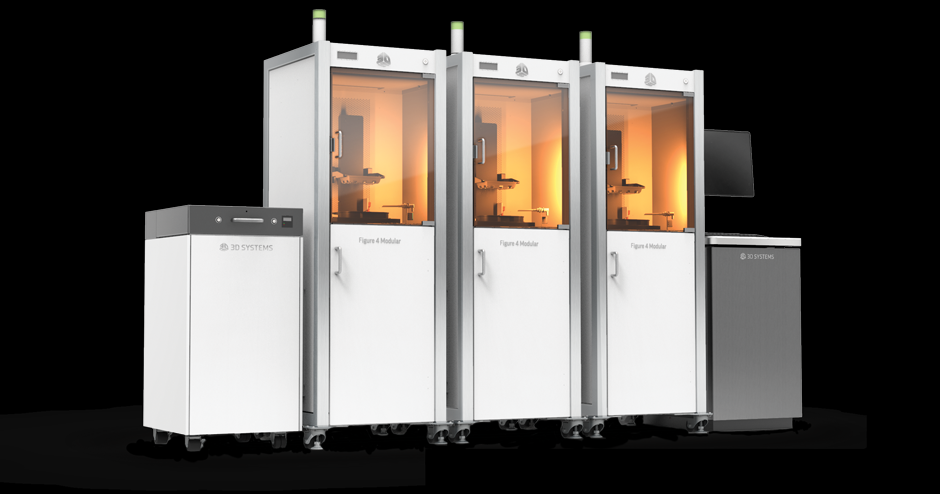Last month Stratasys bought Origin and Desktop Metal bought EnvisionTEC. Both acquisitions were not casual. They were strategic decisions made by companies that, for different reasons, had some cash to bet on the next 3D printing growth area and decided to go for high-speed photopolymerization technology: EnvisionTEC’s founder Al Siblani invented and patented the technology for high-speed, continuous DLP but never thought much of its potential; Origin’s Programmable Photopolymerization (P³) is one of the technologies that went after the potential of these processes for digital mass production through durable photopolymerizable materials.
They are not alone in this race. The trailblazer is Carbon, a company that, through the vision of its founders, single-handedly created this AM hardware segment and then went on to demonstrate that million-part applications were not only possible but also made economic sense. Carbon’s DLS technology is now used by adidas to produce millions of serially manufactured, generatively designed midsoles for the Futurecraft brand. It is used by Ford and even by Lamborghini for final automotive parts and components. And it’s breaking through the dental segment as well. Carbon’s Digital Light Synthesis (DLS) process uses digital light projection, oxygen-permeable optics, and programmable liquid resins to rapidly-produce durable parts with strong mechanical properties, resolution, and surface finish. Before Carbon, speed was never a real issue for DLP technology since the photopolymer resins used were not durable enough to make final products. Carbon’s Co-founder Joe DeSimone had the intuition of mixing durable thermosets such as polyurethane with enough photopolymerizable material to enable the curing, additive reaction. At this point, and with these materials, it started to make sense to go faster. Carbon did, building up a significant lead on all competitors.
Back to the industry
Carbon’s technology, however, is not that revolutionary. The real revolution is in the materials. In fact, as mentioned, EnvisionTEC’s Al Siblani was the first to patent it. However, EnvisionTEC’s products cater to a somewhat restricted group of very high-end adopters who, for different reasons, need resolution and precision more than speed and durability. So EnvisionTEC resisted marketing this technology until Carbon came out with its products and showed that there was a large potential market for it. EnvisionTEC then releases the cDLM series of high-speed photopolymerization printers but never fully believed in pushing them into large-scale production segments. Now that EnvisionTEC has been acquired by Desktop Metal, a company that made digital serial and mass production (of metal parts) its battlecry, all this may change.

Perhaps one of the most innovative, alternative high-speed photopolymerization technologies comes from a company that was built upon—and in fact invented—SLA photopolymerization: 3D Systems. The high-speed photopolymerization technology in 3D Systems’ Figure 4 systems combines speed and accuracy through UV and heat-based curing processes. According to 3D SYstems this yields the world’s fastest additive manufacturing throughput and time-to-part. Recent data highlights Figure 4 Production part print speeds up to 65 mm/hour, and prototyping speeds of up to 100 mm/hour, and part accuracy and Six Sigma repeatability (Cpk > 2) across all materials. The range of Figure 4 materials addresses a wide variety of applications needs, for functional prototyping, direct production of end-use parts, molding and casting, They are durable and can display thermoplastic-like behaviors, rubber-like, castable, heat resistant, and biocompatible capable materials. However, they are not final thermoset materials like Carbon’s.
The West Coast hub
In the meantime, though, a lot of other companies also presented their oheir own versions of high-speed photopolymerization. The most talked about lately is Origin, which was acquired by Stratasys in an effort by the additive industry market leader to capitalize on the expected photopolymer production 3D printing craze. The San Francisco startup (Silicon Valley is the main hub for high-speed photopolymerization, probably due in part to Google’s early investment in Carbon, also based in Silicon Valley) created its Programmable Photopolymerization (P³) technology specifically for high throughput, repeatability and straight-up on-demand production. Their production idea is based on small footprint modular printers that maximize production capacity per available surface.
Also in California is Nexa 3D, a company promoted by former 3D Systems CEO and AM industry pioneer Avi Reichental, through his XponentialWorks venture investment, corporate advisory and product development company. Avi is the Co-founder, Chairman and CEO of the company founded in 2016 together with Andrea Denaro, Gianni Zitelli and Luciano Tringali. Today Nexa3D is emerging as a leading manufacturer of high-speed photopolymerization 3D printers, thanks to its proprietary Lubricant Sublayer Photo-curing technology and patented structured light matrix. This process reduces 3D printing cycles from hours to minutes while maintaining a high level of quality and precision. Nexa3D’s NXV printer reaches a record speed of up to 1 centimeter per minute.
Also on the West Coast, just a few miles North, Vancouver-based NewPro developed the NP1 high speed photopolymerization 3D printers leveraging Intelligent Liquid Interface (ILI) technology. This process is based on a transparent wettable membrane between the photo-curing resin and the light source. The membrane is chemically designed to enable faster movement between cured layers. This eliminates the mechanical processes used on conventional 3D printing techniques allowing to grow objects at high speed. The ILI process can be used with a wide variety of materials for several applications however the company is currently focusing primarily on the medical segment, collaborating with Universities and Hospitals, where the accelerated rate of additive manufacturing contributes to better communication and procedures in radiology and dental departments.
Manufacturing on Demand
A high-speed photopolymerization bridge to Asia
With headquarters in the San Francisco Bay Area and in Bejing, LuxCreo is another high-speed photopolymerization company targeting smart factory additive production capabilities and Digital 3D Production Lines to bring new ideas to market faster. LuxCreo’s Digital 3D Production combines the company’s LUX3 ultra-fast 3D printers, which leverage the company’s LEAP (Light Enabled Additive Production) high-speed DLP technology along with materials, and software to provide a connected, agile, and scalable 3D printing production network. With Digital 3D Production, LuxCreo’s clients can gain instant access to Smart Factory 3D printing production scale.
Acting as a high-speed photopolymerization bridge between America and Asia, LuxCreo brings us to two other Asian companies that have developed high-speed photopolymerization systems to work with durable materials. Korean company Carima was actually one of the very first to do so, launching 3D printers based on proprietary C-CAT (Carima-Continuous Additive Technology) in 2015. The New C-CAT released in 2020 been improved and developed to print faster, more accurate continuous layers. Addressing the issue of using an oxygen layer to release force, which causes the layer to become thinner or disappear due to the inflow of resin, the new C-CAT approach improved the disjunctive surface technology so that it can be less than 1/100th lower than the existing film and thus minimize dissipation. Carima also increased the option to choose output layer thickness. Due to its weak release force, continuous molding is possible during printing, allowing to print output up to 60cm per hour. Supported industrial materials include Tough BLK and Rigid BLK, as well as third-party photopolymers.
Backed by Taiwan’s New Kinpo Group, XYZprinting has been democratizing 3D printing with all major technologies for nearly a decade. The company’s latest high-speed photopolymerization 3D printers can use both DLP and SLA processes. Based on UFF Technology, the systems can boost the printing speed by replacing Teflon film with Ultra Fast Film. It works by reducing the separation force and allows the build platform to move quickly, similarly to the oxygen layer in other layerless photopolymerization processes. UFF brings not only speed but also smooth part finishes through quick and precise layer release from the film.
* This article is reprinted from 3D Printing Media Network. If you are involved in infringement, please contact us to delete it.
Author: Davide Sher




Leave A Comment